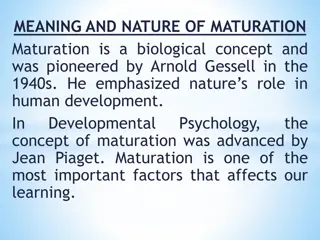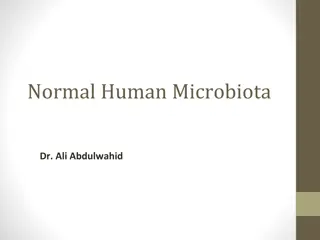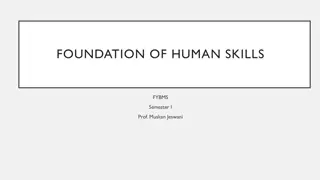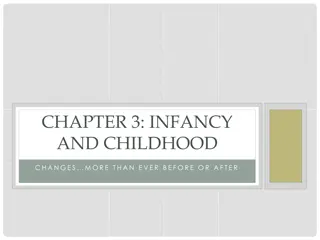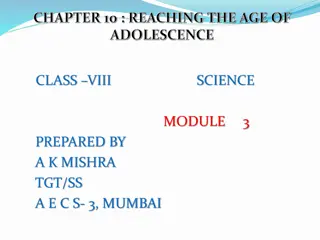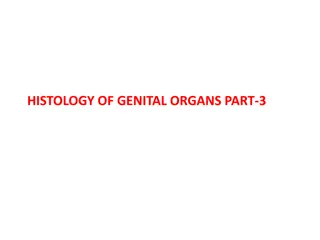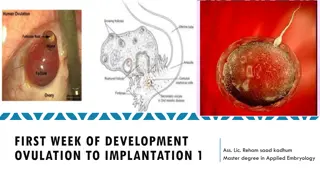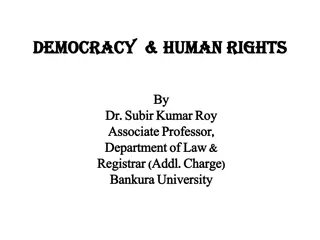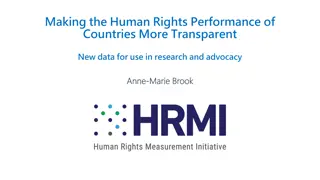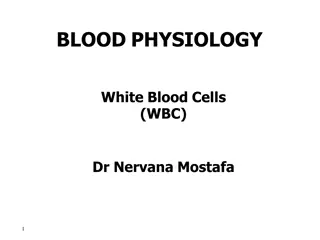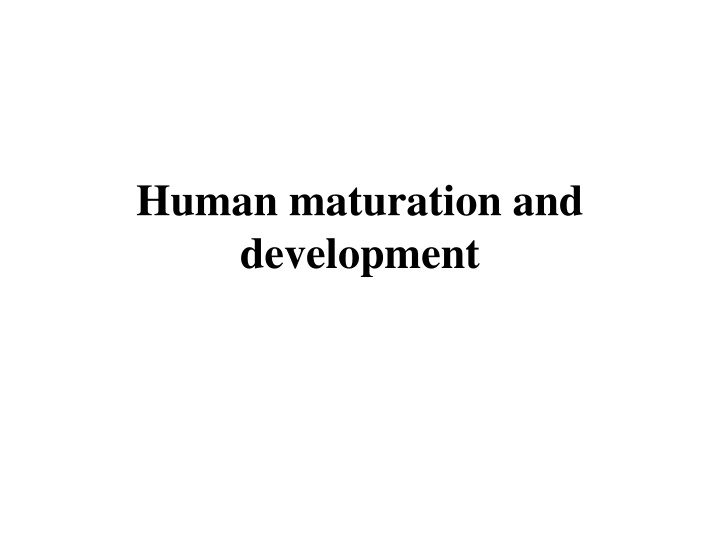
Human Maturation and Development in Children
Explore the concepts of growth and development in children, differentiate between them, learn about the principles of development, the impact of heredity and environment, and factors influencing children's growth. Discover how growth is measurable through indicators like height and weight changes, and understand the common patterns of growth in all children, with variations possible. Witness the rapid growth in early childhood, the slowing down of growth after the first two years, and the notable growth spurt during puberty.
Download Presentation

Please find below an Image/Link to download the presentation.
The content on the website is provided AS IS for your information and personal use only. It may not be sold, licensed, or shared on other websites without obtaining consent from the author. If you encounter any issues during the download, it is possible that the publisher has removed the file from their server.
You are allowed to download the files provided on this website for personal or commercial use, subject to the condition that they are used lawfully. All files are the property of their respective owners.
The content on the website is provided AS IS for your information and personal use only. It may not be sold, licensed, or shared on other websites without obtaining consent from the author.
E N D
Presentation Transcript
Human maturation and development
Objectives At the end of this session, the student will have knowledge about, differentiate between growth and development; the principles of development; the role of heredity and environment on children s development; and the factors affecting growth and development of children.
Definition Growth and development are two related but distinct concepts that describe the changes that occur over time in an individual organism. Growth refers to the increase in size, weight, or importance of an organism or its parts, which can be measured quantitatively. Development refers to the acquisition of skills, abilities, functions, and complexity of an organism or its parts, which can be observed qualitatively
The main indicators of growth are increase in height, weight and changes in the body structure and body proportions. Changes continue to occur in all domains of development but changes that take place in the physical development of children become most visible and apparent. One of the important features of growth is that these changes are measurable.
The sequence, pattern and direction of changes in growth are common to all children although the rate of growth may vary from one child to another. In some cases, like in the case of children with special needs, you may find deviations in different domains of development.
Growth is rapid during the first two years of life. Between birth and first year of life, well-nourished children can undergo a 50 percent increase in height. However, not all parts of the body grow at the same rate. After the first two years of life, growth curve begins to level off and the rate of growth slows down until puberty.
Puberty is marked by a growth spurt i.e. relatively fast increase in height and weight in adolescents.
Physical growth is measured by increase in height and weight at regular intervals. The height of a newborn child ranges from 47 cms to 52 cms. The weight can range from 2.4 kg to 3.2 kg. On an average, increment in weight is 2.0 2.5 kg per year. Boys tend to be heavier and taller than girls during infancy and even as toddlers. A steady increase in both height and weight is a good indicator of satisfactory physical growth.
A height and weight chart is a good way of assessing health and physical development of children. Growth charts that monitor growth should be maintained regularly for all children. Along with an increase in height and weight, body proportions of children also undergo changes. The top of the head appears to be large and the face remains small. Later body proportions change and the head does not look that big.
Throughout infancy and toddler hood, the lower portion continues to remain small and underdeveloped. The growth of the head is proportionately much less after birth as compared to the growth of the other parts of the body. The head increases in size and accounts for one- fourth of a child s length at two years of age.
Compared to the first year, the trunk and limbs begin to grow at a faster pace during toddlerhood. When children are born, their arms appear to be longer in proportion to their legs.At birth, the legs are short and face each other. During the first and second years, the height of infants increases approximately by 40 percent and 60-75 percent respectively, greater than at birth.
As a result of this change, the body of a child looks more proportionate than it did in the first year. This also helps children attain better balance. This pattern of growth remains the same for both boys and girls, but on an average, baby girls are slightly smaller than baby boys in size.
FACTORS AFFECTING GROWTH AND DEVELOPMENT Heredity: Heredity or genetics is found to influence the development of a potential, height, weight and general physical appearance. The genetic makeup inherited from parents seems to be tied to maturation of the body and the brain which influences developmental milestones. intellectual children s growth and
After conception, nothing can be done to add to or subtract from the child s hereditary endowment. These characteristics of the child are also determined at the time of fertilisation. At the time of conception, every child receives 46 chromosomes, of which 23 are contributed by the mother and 23, by the father. The X chromosomes passed on by the father will determine the sex of the child.
To an extent, susceptibility to certain diseases (such as colour blindness, Down s Syndrome, asthma, diabetes) also depends on heredity
Environmental Factors Many environmental factors such as mother s state of health, age, disease and emotional states and exposure of the unborn baby to environmental pollution, to X- rays and drugs affect the child. Certain contextual factors such as family, gender, culture and society at large also influence children s development
Nutrition, health and hygiene needs of a child and the mother Maternal health is an important factor which affects the growth and development of a child. Therefore, it is very important that during pregnancy, the mother takes a balanced diet which is rich in all necessary nutrients. Moreover, antibodies produced by the mother to combat infectious diseases are transmitted to the foetus, usually producing immunity at birth and for some months thereafter.
The placenta also acts as a barrier against some harmful agents, including viruses, microorganisms and various chemicals. Along with mother s and child s nutrition and health, keeping them clean by giving them a regular bath, cleaning of teeth, hair, nails, nose and eyes are other important factors that must be given attention.
Age of the mother Besides the mother s health, her age also affects foetal development. Reproductive organs of mothers who are less than seventeen years of age are not fully mature and the hormones required for reproduction are not at the optimum level. Among young teenagers, pregnancy tends to inhibit the mother s as well as the child s growth
Emotional state of mother Children are not just affected by the mother s physical state but also by the mother s emotional state. Infants born to upset, unhappy mothers are more likely to be premature or have low birth weights, be hyper active and irritable; difficulties such as irregular eating, excessive bowel movements, gas, sleep disturbances and excessive crying. and may manifest
Exposure to X-rays Repeated exposures to radiation during early conception period may have harmful effects on the physical and mental development of the foetus. Drugs Many drugs are suspected of producing birth defects if they are taken during pregnancy. These include some antibiotics, hormones and steroids.
Drinking and Smoking Drinking by pregnant women can produce foetal alcohol syndrome.The symptoms of this condition include retarded prenatal and postnatal growth, premature birth, mental retardation, physical malformations, sleep disturbances and congenital heart disease. Smoking by a pregnant woman retards the growth of the foetus and lowers the newborn s birth weight and resistance to illness. It also increases the chances of spontaneous abortion and premature birth, and may affect long-term physical and cognitive development.
Other Contextual Factors Socio-economic background: Children from different socio-economic backgrounds may vary in terms of their growth and development. This is on account of factors like nutrition and increased health ailments. Living conditions: If living conditions are poor, children may suffer from a variety of diseases leaving them with stunted growth and development.
Family structure: The changing structure of the family from joint to nuclear has decreased the number of persons including children and grandparents that children interact with. This has an impact on their development including development. their socio- emotional
Child-rearing practices: Some parents are authoritarian and make strict rules and regulations that the children must follow. This creates fear and insecurity in the children. On the other hand, some parents take children s choices and opinions into consideration while deciding anything for children. Thus, child rearing practices may have positive or negative impact on the children s development. Abalanced attitude of parents towards children is required.
Enabling enabling and stimulating environment both at home and at school is essential for children s healthy growth and development. The development of children will be positive in a home where they are encouraged to play and interact freely with parents and caregivers. This promotes all the domains of development. Similarly, it is also necessary that children are allowed to ask questions and given an opportunity to explore and experiment at school. and stimulating environment: An
Influence of Siblings: Apart from parents, children are strongly influenced by their siblings. They can be a source of emotional security and can help each other acquire skills. If the parents involve an older child in supporting them in looking after the younger sibling, the child learns responsibility and develops a willingness to share. On the other hand, siblings may develop jealousy and rivalry with each other. Parents should avoid comparing the siblings
Peer group: The peer group helps children to learn and behave in a socially acceptable manner. Acceptance by one's peer group is a strong source of emotional support. Though parents teach social behaviour, it is in the company of friends that children learn sharing, cooperation, autonomy, skills of leadership and a sense of competition.
Gender and Culture: Learning to behave according to the gender roles prescribed by society is an important task that children have to master to be accepted by the peer group. Differences in behaviour shown by boys and girls emerge because of parental and societal expectations.
Often, it is seen that boys are encouraged to fight back and not to cry "like a girl" while crying is accepted in girls when they are attacked. This is harmful as it creates gender stereotypes, and parents and teachers should ensure that no such behaviour is encouraged through action and words. In addition to this, cultural practices also directly and indirectly influence development. growth and children s
Principles of Development Development is continuous and involves change: Development is a sequential process. During infancy, while learning to walk, infants first learn to crawl, then to stand with support, then to stand without support and finally to walk. These changes in body and behavioural pattern, which are indicators of development take place continuously. These changes appear not only in physical features and body structure but also in the socioemotional and cognitive development of children.
Development is sequential: As already mentioned, children learn to stand before walking. Similarly, they scribble before writing. These illustrate that there is a pattern in development. This development is sequential. All children follow more or less similar developmental patterns with one stage leading to the other
The sequential pattern of development proceeds in two directions. First, development proceeds from upper part of the body to the lower part of the body, i.e. from head to toe. This head-to-toe sequence is called Cephalocaudal (Latin head to tail )principle of development. This shows that development in children s head region comes first, followed by trunk region, and finally, in the leg region. This pattern helps to understand why children learn to see an object before they can control their trunk and they learn to sit before they can stand.
Development also proceeds from central parts of the body to peripheral parts referred to as near to far sequence. This is called Proximodistal (Latin, near to far ) principle of development. In a foetus, the head and trunk region gets well developed before the rudimentary limb buds appear. Gradually, the arm buds develop into hands and fingers. That is the reason why children master using their arms before their hands. They develop control over their fingers much later.
Apart from physical and motor development, are there predictable patterns and sequences in other developmental domains. There is a predictable pattern of development for different cognitive functions. Initially, children s thinking is built on concrete objects in their environment and later they can think in terms of abstract ideas as well. Therefore, young children need concrete objects and pictures to manipulate. They learn by doing and engaging in a variety of activities. Later, children develop concepts in abstract terms also.
Development is a product of maturation and learning Normally most children learn to sit around at the age of six months, stand while holding in eight to nine months take their first steps between 9 and 12 months and start walking by 13 to 15 months. Under normal circumstances, all children have the potential to sit, stand and walk. But they can perform the particular tasks only when they get physically and mentally mature.
Maturation is the unfolding of characteristics potentially present in the individual. This comes from genetic endowment. Learning brings change environmental learning which includes effort and exercise. Maturation and learning are closely related, one influences the other. Children develop as per their internal genetic characteristics as well as external environmental inputs. Thus, development is the product of maturation and learning. in behaviour due to
There are individual differences in development At each stage of development, one can expect certain competencies to appear development. These are milestones. Milestones of development present the age ranges during which the majority of children accomplish age specific skills. in every domain developmental of called
It is important to note that there are individual differences in development. No two children are alike. Each child is unique. One child may start speaking early and the other might take more time to speak. The range of variability depends on many factors like heredity and environment. Each child has different experiences that interact with the unique hereditary pattern.
Although the sequence of development is fairly uniform, predetermined and common to all children, the rate and pace of development may vary from child to child. Developmental differences are routine among children unless a child deviates drastically from the normal developmental pattern.
The child develops as a unified whole Different domains of development are interrelated and therefore the child develops as a unified whole. Each domain of development affects the other and is, in turn, affected by the others. Any problem in one aspect of development is likely to affect others. For example, a child who may be either chronically ill or may have delayed physical-motor development, may not subsequently in physical children. be able to participate with activities other
As a result, the child may not get a chance to mingle with other children and this may affect all other aspects of development including social-emotional, cognitive and language.
Sensory development Sensory development in early childhood is important for overall health and well being. It forms the foundation of a child s learning and perception. Touch, taste, sight, hearing and smell. These are the five basic senses
1. Sight (Visual) Through the sense of sight we are able to: Interpret the information that we see. Recognize objects or the environment around us. See where we are moving and navigate through space. Receive information (through the eyes) and transfer the information to the rest of the body so that we can react and respond to our environment. Build language and vocabulary by naming what we see.
Sight is the least developed of the senses at birth. Babies cannot focus clearly or see further than 30cm ahead of them. Visual stimulation right from birth is very important in order to develop this sense. Your baby must learn: How to follow objects with his eyes. To distinguish between colours. How to get the eyes to work together.
Hand-eye coordination. Spatial perception where he is in relation to things around him. Depth perception what is in front or close, what is behind or far away. Between 1 year and 18 months, children have the same vision as an adult. Exercises such as making your baby follow a toy with his eyes will not only strengthen the eye muscles but also improve his visual perception an important skill needed to read later on.
2. Hearing (Auditory) Through the sense of hearing we are able to: Sense and interpret sounds that we hear. Determine what direction the sound is coming from. Determine the distance of the source of the sound. Understand the importance of a sound (e.g. a car speeding towards you when you are crossing the road is a sound of danger in that context).
The auditory system is better developed at birth than the sense of sight. This is because it is already developed by 28 weeks of gestation. Sound is carried on airwaves which is picked up by receptors in the ear. Newborns can identify their mother s voice early on and can hear high-pitched sounds well. Hearing and listening are crucial skills during childhood and are closely linked to learning. The better children are able to hear and listen, the better their intellectual development will be.
This is because they have developed good auditory perceptual skills. They will also be less frustrated than children who can t learn as easily because they cannot process sounds well.



